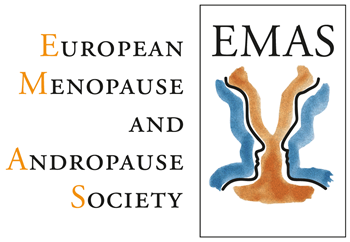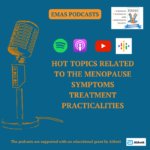Host: Welcome to today’s podcast. Premature Ovarian Insufficiency: How to diagnose and treat. This episode is part of a podcast series supported by Abbott. The content is solely the responsibility of EMAS, the European Menopause and Andropause Society. All our episodes are available in English, Spanish, Mandarin, and Russian, and you can find them on any of the most popular podcast platforms.
On today’s episode, Dimitrios Goulis, Professor in Reproductive Endocrinology at the Aristotle University of Thessaloniki, Greece, and the current president of the European Menopause and Andropause Society will help us understand the definition, the causes, and the diagnostic and therapeutic approach of premature ovarian insufficiency.
Prof. Dimitrios Goulis: Premature ovarian insufficiency is defined as a deficiency of ovarian function in a woman under the age of 40 years. Both endocrine function, that is lack of estrogen production and exocrine function, that is depletion of ovarian reserve, are affected. Premature ovarian insufficiency affects 1 to 3% of women during their reproductive age.
Interviewer: What are the causes of premature ovarian insufficiency?
Prof. Goulis: Despite the advantage of understanding the pathophysiology of the disease, the etiology remains unknown in 80% of cases. Known causes of ovarian failure include chromosomal defects such as Turner syndrome and Fragile X syndrome permutation carriers, exposure to radiation, use of certain medication, and autoimmune disease.
Interviewer: Is premature ovarian insufficiency similar to menopause, except for the early age onset?
Prof. Goulis: No. In contradistinction to natural menopause, intermittent ovarian function occurs in 75% of women with spontaneous premature ovarian insufficiency. This difference may alter the symptomatology but may be intermittent and variable in severity. Most importantly, the intermittent ovarian function increases the probability of pregnancy either spontaneously or via Assisted Reproduction Techniques.
Interviewer: How premature ovarian insufficiency is diagnosed?
Prof. Goulis: The presenting symptoms are similar to those of menopause. They include changes in menstrual function, that is oligomenorrhea or amenorrhea, and symptoms of estrogen deficiency, either vasomotor, hot flashes, night sweats, or urogenital (vaginal dryness). A profile of increased follicle-stimulating hormone and decreased estradiol concentration on two occasions set the diagnosis.
Serum concentrations of anti-Mullerian hormone and antral follicle count through an ovarian ultrasound are the best ways to quantify ovarian reserves in terms of remaining follicles. Further investigation may be needed to establish the specific cause for premature ovarian insufficiency in case this is possible.
Interviewer: What are the treatment options for estrogens?
Prof. Goulis: Estrogen deficiency is effectively and safely treated by hormone replacement therapy. Several studies provided evidence that the benefits exceeded the risks. Hormone replacement therapy will alleviate estrogen deficiency symptoms, prevent long-term health consequences such as osteoporosis, coronary heart disease and stroke, improve quality of life, and maintain sexual function. Some women may need vaginal estrogen in addition to systemic ones. Therefore, it should always be offered unless there is an absolute contraindication.
Hormone replacement therapy for premature ovarian insufficiency should mimic normal ovarian function. So, 17 beta estradiol and micronized progesterone via the transdermal or oral route are obvious choices. Girls and young women with primary amenorrhea in whom secondary sex characteristics have not developed should initially be given very low doses of estradiol.
At first, without the progestogen to mimic gradual pubertal maturation. Women with secondary amenorrhea may be given full replacement dose. Indicatively, two milligrams per day for oral estradiol on 100 microgram patches twice a week for transdermal estradiol.
Hormone replacement therapy must be continued until the age of natural menopause, 50 to 51 years. Hormonal contraception options must be offered to women for whom pregnancy prevention is a priority.
Interviewer: What are the treatment options for infertility?
Prof. Goulis: Although some women can conceive without treatment, spontaneous pregnancy rates are low — 5 to 10%. Options for pregnancy achievement include in vitro fertilization (IVF) and oocyte donation. At the time of diagnosis, women will often ask about the possibility of oocyte cryopreservation. The latter may be offered in women with known genetic risk for premature ovarian insufficiency before ovarian function declines.
Interviewer: What will be your overall conclusion for premature ovarian insufficiency?
Prof. Goulis: The diagnosis of premature ovarian insufficiency may be disturbing for a young woman who has not started or completed her childbearing plans. Nevertheless, this woman must be reassured that it is a treatable condition. Restoration of menses and provision of female hormones can be achieved by hormone replacement therapy, and pregnancy can be accomplished by various methods starting from spontaneous conception and ending to oocyte donation according to the ovarian reserves. So, a woman with premature ovarian insufficiency can have a normal life without restrictions.
The European Menopause and Andropause Society, EMAS, has produced a position statement for premature ovarian insufficiency which can be downloaded for free from the EMAS website, emas-online.org, together with loads of educational material.
Host: Today, Professor Dimitrios Goulis discussed the definition, the causes, and the diagnostic and therapeutic approach of premature ovarian insufficiency. Thank you for listening to today’s episode. We hope it will be valuable for your clinical and research practice. Stay safe.
[END]


